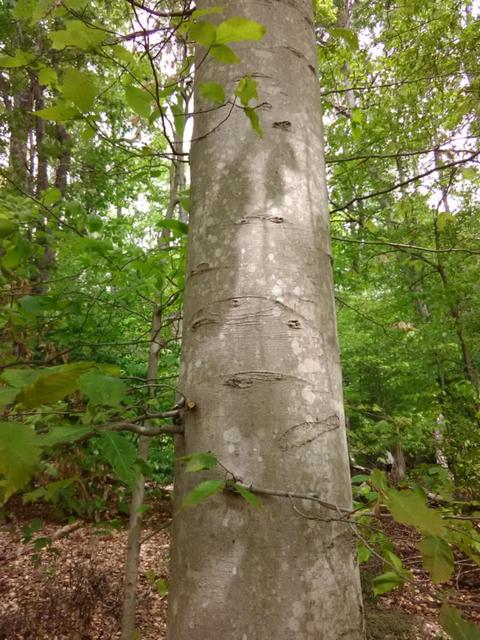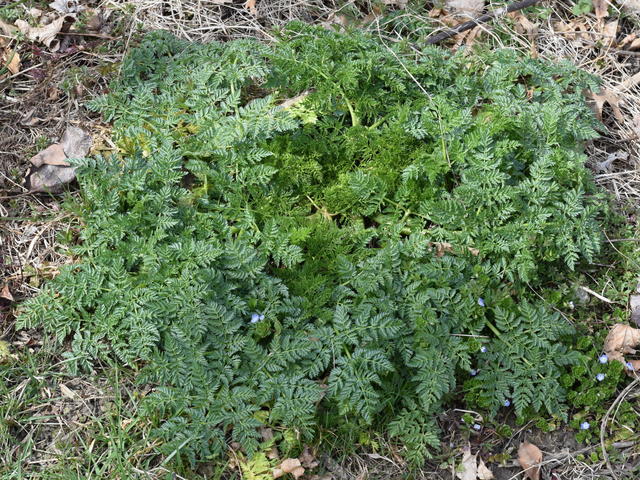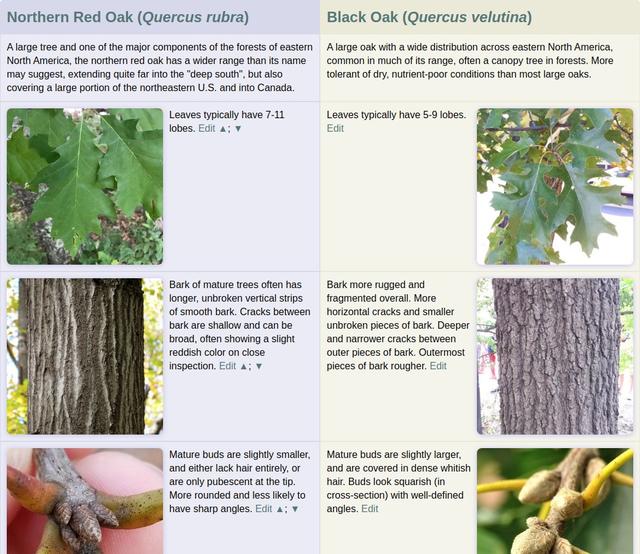Plant Comparison and ID Guides
October 30th, 2019 by Alex Zorach
One of the biggest challenges with plants is accurately identifying them. Many people do not even have names for the majority of plants they see as they go through the day. Even among gardeners and others who work closely with plants, misidentifying plants is common.Why is plant identification important?
Plant identification opens the door to learning about individual plants and enables us to make better choices involving plants. Knowing a plant's name enables you to research its range, native vs. introduced status, growing conditions, growth habit and characteristics, ecological relationships, uses, control methods, and more.In many cases, ID characteristics and ecology go hand in hand. For instance, the smooth bark of the American beech (Fagus grandifolia) reflects its vulnerability to fire, whereas the rugged bark of the bur oak (Quercus macrocarpa) reflects its fire resistance.
 The smooth bark of the American beech is a key ID characteristic, but also reflects this species' vulnerability to fire. Thick, rugged bark provides insulation to protect trees from fire. Beeches and other thin-barked trees thus tend to occur only in consistently-moist habitats that do not experience wildfires. Photo by Claire Secrist, Public Domain.
The smooth bark of the American beech is a key ID characteristic, but also reflects this species' vulnerability to fire. Thick, rugged bark provides insulation to protect trees from fire. Beeches and other thin-barked trees thus tend to occur only in consistently-moist habitats that do not experience wildfires. Photo by Claire Secrist, Public Domain.If you are managing a wild area for native plants, being able to reliably ID plants can tell you which species to remove and which to encourage. You can gather seeds from wild populations, and grow them in your garden, or get them established in wild areas you are working to restore.
Misidentification can have consequences. Some poisonous plants look disturbingly similar to common food plants, and some plants such as poison ivy can even be dangerous to touch. In many cases, native plants can look similar to closely-related invasive plants. Nurseries can mislabel plants, and cultivars can complicate matters by altering the characteristics typically used to identify plants. Even when plants are not invasive, a mis-identification can lead to growing something in a garden or landscape that is poorly suited to the site. A mis-ID'ed plant may die if planted in unsuitable conditions, or it may grow larger than wanted and require costly pruning or cause property damage.
 Poison hemlock, pictured here, looks similar to parsley and carrots. This similarity can be dangerous because the plant is highly toxic. This plant belongs to the carrot family (Apiaceae) which is notorious for containing both poisonous plants and food plants, many of which are hard to tell apart.
Poison hemlock, pictured here, looks similar to parsley and carrots. This similarity can be dangerous because the plant is highly toxic. This plant belongs to the carrot family (Apiaceae) which is notorious for containing both poisonous plants and food plants, many of which are hard to tell apart.Plant Comparison Guides: Side-by-Side Comparisons
With these purposes in mind, we are excited to announce our publishing of plant comparison guides!Our plant comparison guides take two species that overlap in range and are commonly confused, and compare them side-by-side in a table.
 This screenshot shows how the table appears on a desktop device or other device with a wide screen; the table collapses gracefully on small mobile devices as well.
This screenshot shows how the table appears on a desktop device or other device with a wide screen; the table collapses gracefully on small mobile devices as well.How are we choosing which guides to write?
We have been using data from iNaturalist, a citizen science website and app, and focusing on plants that are commonly misidentified in photos on that site. One of the weaknesses of iNaturalist is that their site is littered with misidentifications, but this weakness can be turned into an asset because the site's active user base of casual users provides an excellent source of data on which plants are most commonly confused. Because the data comes from real observations in the wild, it also takes into account the increased likelihood of confusion based on plants whose ranges and habitat overlap.However, even using iNaturalist as a guide, there are potentially thousands of these comparisons that we could be writing, so prioritization is critical. We want to write the guides that people most want to read. If you have a specific guide that you would like us to write, please get in touch!
Where can you find these guides on our site?
Currently, any published guides are displayed on the page for each species. There is a new "Similar Plants" section, and a link to it will be displayed in the table of contents at the top of each page that has such a section. This section is different from the "Related Plants" section that some articles have; the "similar plants" section is primarily for plants that are visually confused. They may or may not be related.For example, Box Elder (Acer negundo) is a maple, but with its compound leaves it is more often confused with poison ivy or ash trees, and less frequently with other maples. Sugar Maple (Acer saccharum), on the other hand, has a more "typical" maple leaf and thus it is more often confused with other maples. Pictured here is the page of comparisons for sugar maple:
 You can find completed comparison guides in the "Similar Species" section. Click "View" to be taken to the page for that species, or "Compare" to view the comparison and ID guide.
You can find completed comparison guides in the "Similar Species" section. Click "View" to be taken to the page for that species, or "Compare" to view the comparison and ID guide.Check out the guides for yourself!
Here is a sampling of some of the guides we have completed:- Red Maple vs Sugar Maple
- Norway Maple vs Sugar Maple
- White Snakeroot vs Late Boneset
- Northern Red Oak vs Black Oak
- Eastern Poison Ivy vs Fragrant Sumac
- Box Elder vs Eastern Poison Ivy
- Eastern Poison Ivy vs Boston Ivy
- American Beech vs European Beech
- Norway Maple vs Red Maple
- Red Maple vs Mountain Maple
- Silver Maple vs Sugar Maple
- Red Maple vs Silver Maple
And please send us your requests! You can ask us to make comparisons for a specific plant, a specific pair of plants, or a specific set of features for a pair of plants (such as if we haven't yet shown a picture of the bark, or flowers, or buds of a particular tree.)
And let us know if you have any corrections, find any major omissions, or have any photographs that you think could improve on our offerings. We want our ID guides to be as good as they can be!
Also, if you have not yet done so, please consider donating to support our work!
Archive of All Blogs
The Bias Against Tall Plants, November 11th, 2025
A Focus on Goldenrods (Solidago sp.), July 23rd, 2025
Disturbance and its Role in Plant Habitat Preferences, May 29th, 2025
What "Native" or "Introduced" Mean: Myths and Misconceptions, March 11th, 2025
Smarter & More Informative Search Results, January 13th, 2025
The Effect of the 2024 US Election on Plant Biodiversity and bplant.org, October 30th, 2024
The Problems With Nursery-Bought Plants, And The Solutions, October 8th, 2024
More Databases Linked & Search Improvements for Scientific Names, July 9th, 2024
Choosing The Best Common Names For Plants: Challenges & Solutions, April 19th, 2024
Range Map & Taxonomic Update Progress, January 31st, 2024
Giving Thanks To Everyone We Rely On, November 22nd, 2023
Thinking More Deeply About Habitat, April 5th, 2023
2022 Year-End Summary: Successes & New Goals, February 15th, 2023
New Databases Linked: Flora of North America & NatureServe Explorer, November 11th, 2022
All Range Maps 2nd Generation, Taxonomic Updates, & Fundraising Goal Met!, September 29th, 2022
More Range Map Improvements, POWO Interlinking, And Notes Fields, June 7th, 2022
Ecoregion-Based Plant Lists and Search, March 30th, 2022
Progress Updates on Range Maps and More, February 10th, 2022
The Vision for bplant.org, December 9th, 2021
New Server: Software & Hardware, August 30th, 2021
More & Improved Plant Range Maps, July 19th, 2021
A Control Section for Invasive Plants, April 15th, 2021
Progress Bars & State Ecoregion Legends, March 11th, 2021
Our 2020 Achievements, February 9th, 2021
Interlinking Databases for Plant Research, November 11th, 2020
A New Homepage, Highlighting Our Articles, July 29th, 2020
A False Recovery, But North Carolina's Ecoregions are Complete!, June 9th, 2020
We're Back After COVID-19 Setbacks, April 3rd, 2020
Help Us Find Ecoregion Photos, February 27th, 2020
What We Achieved in 2019, December 30th, 2019
Plant Comparison and ID Guides, October 30th, 2019
We Are Now Accepting Donations, October 14th, 2019
US State Ecoregion Maps, New Footer, Ecoregion Article Progress, and References, September 19th, 2019
Tentative Range Maps of Native Plants, August 12th, 2019
Ecoregion Locator and Interactive Maps, July 10th, 2019
Using Ecoregions Over Political Boundaries, May 13th, 2019
How We Handle Wild vs Cultivated Plants, April 16th, 2019
A Blog To Keep People Updated On Our Progress, April 8th, 2019
Sign Up
Want to get notified of our progress? Sign up for the bplant.org interest list!


